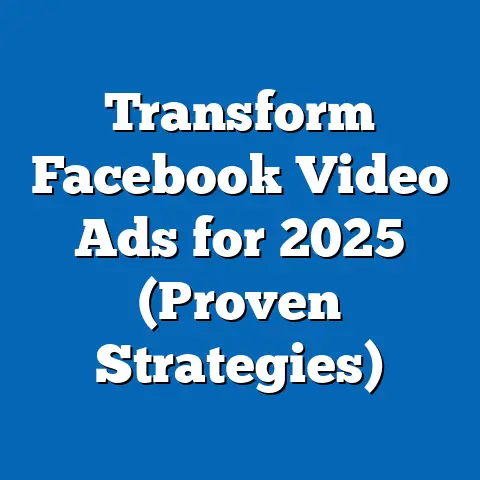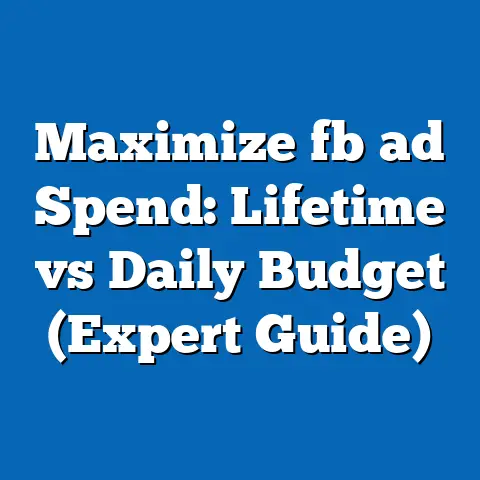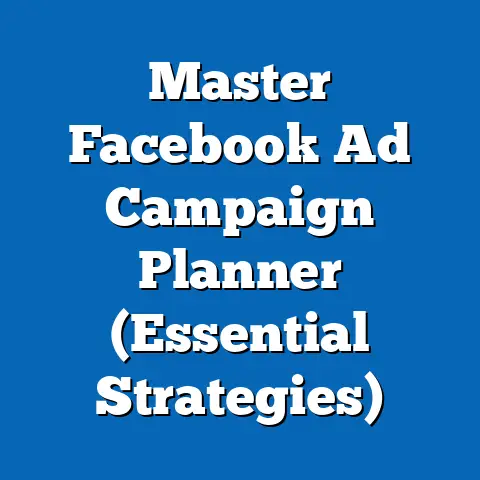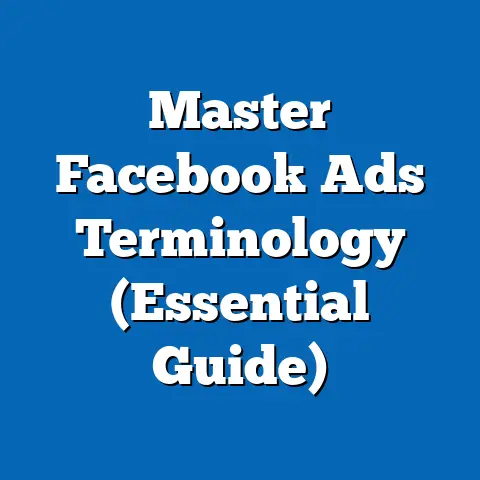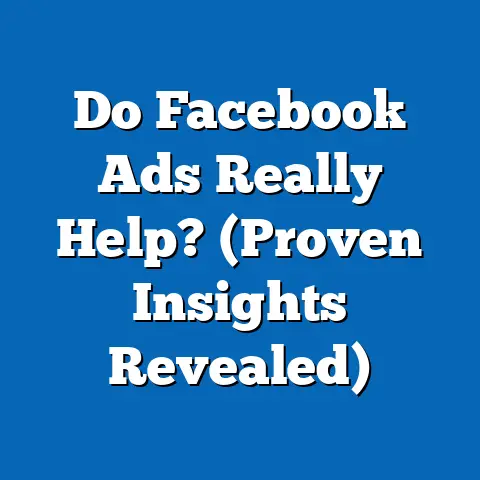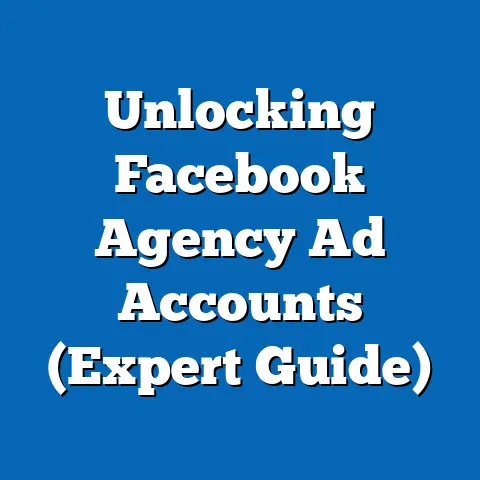Elevate Facebook Ad Creativity (Proven Design Strategies)
In today’s fast-paced digital world, technology is evolving at an unprecedented rate, and its impact on digital marketing, particularly on platforms like Facebook, is undeniable. Innovations like artificial intelligence (AI), augmented reality (AR), and advanced data analytics have revolutionized the advertising landscape. These technologies have not only reshaped consumer behavior but have also significantly raised the bar for creativity in ad design.
As a digital marketing specialist with years of experience crafting Facebook ad campaigns, I’ve witnessed firsthand how a creative, well-designed ad can cut through the noise and grab attention. But it’s not just about pretty visuals anymore. Today, successful Facebook ads are a blend of art and science, leveraging technology and data to deliver a message that resonates deeply with the target audience.
In this article, I’ll explore proven design strategies that leverage these technological innovations to create effective advertising campaigns. We’ll dive into understanding your audience, crafting eye-catching visuals, leveraging innovative technologies, and creating compelling copy that drives results. My goal is to provide you with actionable insights that you can immediately implement to elevate your Facebook ad creativity and achieve your marketing objectives.
Understanding the Facebook Audience
One of the foundational pillars of effective Facebook advertising is understanding your audience. It’s not enough to simply know their age, location, and gender; you need to delve into their demographics and psychographics to truly connect with them. Tailoring your ad designs to resonate with your target audience is crucial for driving engagement and achieving your marketing goals.
Facebook boasts a diverse user base, spanning various age groups, interests, and lifestyles. Understanding the nuances of these different audience segments is essential for crafting effective ad campaigns. For example, Millennials might respond well to visually appealing, authentic content, while Gen Z might prefer short, engaging videos with a touch of humor. Baby Boomers, on the other hand, might appreciate informative and trustworthy ads that speak to their specific needs and concerns.
I’ve found that creating detailed audience personas can be incredibly helpful in this process. A persona is a semi-fictional representation of your ideal customer, based on research and data about your existing and potential customers. By developing these personas, you can gain a deeper understanding of their motivations, pain points, and preferences, which will inform your ad design choices.
Personalization is key. Generic ads that attempt to appeal to everyone often end up appealing to no one. According to a recent study by Epsilon, 80% of consumers are more likely to make a purchase when brands offer personalized experiences. This underscores the importance of creating ad designs that speak directly to the individual needs and interests of your target audience.
For example, if you’re targeting fitness enthusiasts, you might use images of people working out, motivational quotes, and copy that highlights the benefits of your fitness products or services. On the other hand, if you’re targeting busy professionals, you might use images of people working in a modern office, copy that emphasizes efficiency and productivity, and a call to action that encourages them to learn more about your time-saving solutions.
Key Takeaway: Understanding your Facebook audience is paramount to creating effective ad designs. By delving into their demographics, psychographics, and preferences, you can tailor your ads to resonate with them on a deeper level, driving engagement and achieving your marketing goals.
Crafting Eye-Catching Visuals
Visuals are the first thing that catches the eye on a busy Facebook feed. In a world saturated with content, your ad needs to stand out to grab attention and make a lasting impression. Crafting eye-catching visuals is an art form that requires careful consideration of various design elements, including color psychology, typography, imagery, and video content.
Color Psychology
Colors have a powerful impact on our emotions and perceptions. Different colors evoke different feelings and can influence how viewers perceive your brand and message. Understanding color psychology is crucial for creating ad designs that resonate with your target audience.
For example, blue is often associated with trust, reliability, and security, making it a popular choice for financial institutions and technology companies. Green is often associated with nature, health, and sustainability, making it a good choice for eco-friendly brands and wellness products. Red is often associated with excitement, passion, and energy, making it a good choice for brands that want to create a sense of urgency or excitement.
I’ve seen firsthand how a simple change in color can significantly impact ad performance. For instance, a client who sold organic skincare products saw a 20% increase in click-through rates after switching from a red-themed ad to a green-themed ad.
Typography
Typography is another crucial element of visual design. The font you choose can convey your brand personality and ensure readability. Selecting fonts that complement the overall design and are easy to read is essential for creating effective Facebook ads.
Consider your brand’s personality when choosing a font. A modern, minimalist brand might opt for a clean, sans-serif font, while a more traditional brand might choose a serif font with a classic feel. Ensure that your font is legible, especially on smaller screens. Avoid using overly decorative or script fonts that can be difficult to read.
Imagery and Graphics
Images and graphics play a vital role in storytelling within ads. High-quality visuals can capture attention, convey emotions, and communicate your message in a memorable way. User-generated content (UGC) can add authenticity and build trust with your audience.
When selecting images, choose high-resolution photos that are relevant to your brand and message. Consider using images that feature real people, as they tend to be more relatable and engaging than stock photos. I’ve always found that incorporating UGC, such as customer photos and testimonials, can significantly boost credibility and drive conversions.
Video Content
Video ads are increasingly popular on Facebook, and for good reason. Dynamic visuals can enhance engagement and communicate your message in a more compelling way than static images. Creating compelling video content that aligns with your brand messaging is essential for success.
Keep your videos short and engaging. Facebook users have short attention spans, so it’s important to grab their attention quickly and keep them hooked. Use eye-catching visuals, compelling storytelling, and a clear call to action to maximize engagement.
Key Takeaway: Eye-catching visuals are essential for capturing attention and making a lasting impression on Facebook. By carefully considering color psychology, typography, imagery, and video content, you can create ad designs that resonate with your target audience and drive results.
Leveraging Innovative Technologies
In today’s rapidly evolving digital landscape, leveraging innovative technologies is crucial for staying ahead of the curve and maximizing the impact of your Facebook ad campaigns. Artificial intelligence (AI), augmented reality (AR), and data analytics offer powerful tools for boosting creativity and optimizing ad performance.
Artificial Intelligence
AI can assist in optimizing ad performance through predictive analysis and design suggestions. AI-powered tools can analyze vast amounts of data to identify patterns and trends, providing valuable insights that can inform your ad design choices.
For example, AI can predict which ad creatives are most likely to resonate with your target audience, allowing you to focus your efforts on the most promising designs. AI can also automate design processes, such as image resizing and text optimization, freeing up your time to focus on more creative tasks.
I’ve been experimenting with AI-powered design tools and have been impressed with their ability to generate high-quality ad creatives in a fraction of the time it would take to create them manually. These tools can be particularly helpful for small businesses with limited design resources.
Augmented Reality (AR)
AR experiences can create immersive ads that engage users on a deeper level. AR allows users to interact with your products or services in a virtual environment, creating a more engaging and memorable experience.
For example, a furniture retailer could use AR to allow users to see how a piece of furniture would look in their home before making a purchase. A cosmetics brand could use AR to allow users to virtually try on different shades of lipstick or eyeshadow.
I’ve seen several brands successfully integrate AR into their Facebook campaigns, resulting in increased engagement, brand awareness, and sales. AR is a powerful tool for creating immersive and interactive ad experiences that capture attention and drive results.
Data Analytics
Data-driven insights can inform design choices and help you refine your ad creatives based on performance metrics. A/B testing is a crucial tool for optimizing your ad designs. By testing different variations of your ads, you can identify which elements resonate most with your target audience and make data-driven decisions to improve performance.
For example, you could test different headlines, images, calls to action, and targeting options to see which combinations generate the best results. Data analytics can also help you identify which audience segments are most responsive to your ads, allowing you to tailor your designs to specific groups.
Key Takeaway: Leveraging innovative technologies like AI, AR, and data analytics is essential for boosting creativity and optimizing the performance of your Facebook ad campaigns. These tools provide valuable insights and capabilities that can help you create more engaging, relevant, and effective ads.
Creating Compelling Copy
While visuals are essential for grabbing attention, compelling copy is what seals the deal. Your ad copy should complement your visual elements and persuade viewers to take the desired action, whether it’s visiting your website, making a purchase, or signing up for your email list.
Crafting Attention-Grabbing Headlines
Your headline is the first thing that viewers read, so it’s crucial to make it count. An attention-grabbing headline can pique interest and encourage viewers to click on your ad.
Use strong verbs and keywords that resonate with your target audience. Highlight the benefits of your product or service, and create a sense of urgency or curiosity. I’ve found that asking a question or making a bold statement can be an effective way to grab attention.
Call to Action (CTA)
A strong call to action (CTA) is essential for guiding users toward the desired action. Your CTA should be clear, concise, and persuasive. Use action-oriented language that encourages viewers to take the next step.
For example, instead of using a generic CTA like “Learn More,” try something more specific and compelling, such as “Shop Now,” “Get Your Free Trial,” or “Download Your Guide.” Ensure that your CTA aligns with the overall ad design and message.
Storytelling
Storytelling is a powerful tool for creating an emotional connection with your audience. By telling a compelling story, you can capture attention, build trust, and inspire action.
Focus on the benefits of your product or service and how it can solve a problem or improve your audience’s lives. Use vivid language and imagery to create a memorable and engaging experience.
Key Takeaway: Compelling copy is essential for complementing your visual elements and persuading viewers to take the desired action. By crafting attention-grabbing headlines, using strong calls to action, and telling compelling stories, you can create ad copy that drives results.
Conclusion
Elevating Facebook ad creativity is not just about aesthetics; it’s about leveraging technology, understanding your audience, and creating a cohesive message that resonates with them. By implementing the proven design strategies outlined in this article, you can create impactful ads that stand out in a competitive digital landscape.
Remember to continuously test and refine your ad designs based on data-driven insights. The digital landscape is constantly evolving, so it’s essential to stay up-to-date with the latest trends and best practices.
By embracing these strategies, you can unlock the full potential of Facebook advertising and achieve your marketing objectives. Now, go forth and create ads that captivate, engage, and convert!

